MaryAnn Bernal's Blog, page 294
April 11, 2014
Rare clay sarcophagus found in Israel alongside Seti I scarab seal ring
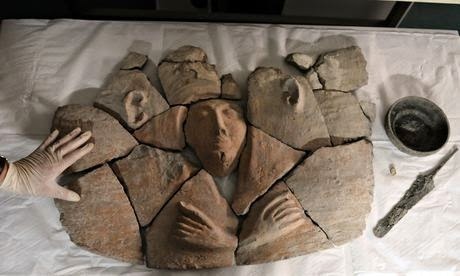 Part of the lid of the coffin, featuring the slender sculpted face, which was discovered in Israel's Jezreel valley. Photograph: Mahmoud Illean/Demotix/Corbis Archaeologists unearth 3,300-year-old coffin at Tel Shadud thought to hold Canaanite official in service of Egyptian pharaoh
Part of the lid of the coffin, featuring the slender sculpted face, which was discovered in Israel's Jezreel valley. Photograph: Mahmoud Illean/Demotix/Corbis Archaeologists unearth 3,300-year-old coffin at Tel Shadud thought to hold Canaanite official in service of Egyptian pharaohIsraeli archaeologists have unearthed a rare sarcophagus featuring a slender face and a scarab ring inscribed with the name of an Egyptian pharaoh, Israel's antiquities authority said on Wednesday.
The mystery man whose skeleton was found inside the sarcophagus was most likely a local Canaanite official in the service of ancient Egypt, Israeli archaeologists said.
"This is a really beautiful face, very serene," said Edwin van den Brink, an Egyptologist and archaeologist with the antiquities authority. "It's very appealing."
Van den Brink said archaeologists had been excavating at Tel Shadud, an archaeological mound in the Jezreel valley, from December until last month.
The archaeologists first uncovered the foot of the sarcophagus and took about three weeks to work their way along the coffin. Only as one of the dig's last days arrived did they brush away the dirt to uncover the carved face.
The lid of the clay sarcophagus is shattered, but the sculpted face remains nearly intact. It features graceful eyebrows, almond-shaped eyes, a long nose and plump lips. The ears are on shards separated from the face, and the long-fingered hands are depicted as if the arms were crossed atop the chest, in typical Egyptian burial pose.
Experts last found such a sarcophagus about a half a century ago in Deir al Balah, in the Gaza Strip, where 50 similar coffins were dug up, mostly by grave robbers, Van den Brink said. Some of the coffins are placed now near the entrance to the archaeology wing at the Israel Museum, in Jerusalem. Dozens were previously found in Beit Shean, in the north of Israel.
Found alongside the new sarcophagus was a scarab seal ring encased in gold, carved with the name of Pharaoh Seti I, who ruled ancient Egypt in the 13th century BC.
Seti I conquered the region of today's Israel in the first year of his reign in order to secure Egyptian trade routes and collect taxes for Egypt, said Ron Beeri, an archaeologist who participated in the dig. The man buried in the sarcophagus might have been a tax collector for the pharaoh, Beeri added.
Seti I was the father of Ramses II, often identified as the pharaoh in the biblical story of the Israelite exodus, though Beeri said there was no historical evidence to support that.
DNA tests may be conducted to determine if the man in the sarcophagus was Canaanite or Egyptian, Beeri said.
The recent archaeological discovery, like most in Israel, came by happenstance. Israel's natural gas company called in archaeologists to survey the territory before laying down a pipeline.
Van den Brink said the antiquities authority excavated only a small area, of five metres by five metres (16ft x 16ft), but that that had been enough to locate the sarcophagus, the scarab and four other human remains.
Van den Brink said the site could have been a large cemetery, so other sarcophagi could be found in future digs. "It's just a small window that we opened," he said.
http://www.theguardian.com/world/2014/apr/09/sarcophagus-archaeologists-israel-seti-egyptian-tel-shadud

Published on April 11, 2014 13:34
An excerpt from 'What Happened to Alex Manning' by Kim Scott
 From the pen of Kim ScottThis is an excerpt from 'What Happened to Alex Manning', set in Maine in the early 1900s. This is book 1 of 2 that follows Alex Manning and his family through the Roaring 20s, into the Prohibition Era and the Great Depression.
From the pen of Kim ScottThis is an excerpt from 'What Happened to Alex Manning', set in Maine in the early 1900s. This is book 1 of 2 that follows Alex Manning and his family through the Roaring 20s, into the Prohibition Era and the Great Depression. If you like historical fiction seasoned with murder, treachery, love, loyalty, and shocking twists, then this is a must read at only .99, £0.77 or CDN$1.10 on Kindle & Noo...k.
Alex reached the balustrade and grasped Charlotte’s wrist. The full truth of it all struck him, forcefully. He needed to stop; to replay the events in his head and sort out the details. He desperately needed time. If only Charlotte would wait and allow him to think it through.
Charlotte’s shrill scream jumbled the thoughts whirling in his head. Urgently, he fought to put them in order again and make sense of everything. His anger dissipated as he struggled with the horrifying memories. With his heart thumping wildly, a sharp pain shot through his head.
If only Charlotte would stop. In her panicked state, she struggled with him certain that he meant to harm her. He stammered crazily as she flailed at him with tight fists. Terrified, he felt her pull away and she teetered backward at the edge of the top step.
Her arms pin wheeled twice, as her shoes slipped on the smooth marble. Alex grasped her arm and wrenched her back with all of his strength. She flew by him and slammed into the wall across the hall, coming to rest in a heap there. Off balance at the top of the stairs, Alex fell forward, reaching for the balustrade as he went. With nothing to stop him from falling, he tumbled, thumping and banging, all the way to the stone floor below.
http://www.amazon.com/What-Happened-Alex-Manning-Family-ebook/dp/B00DXKJK64
http://www.amazon.co.uk/What-Happened-Manning-Family-Series-ebook/dp/B00DXKJK64
http://www.amazon.ca/gp/product/B00DXKJK64
http://www.barnesandnoble.com/w/what-happened-to-alex-manning-kim-scott/1117056687?ean=2940148375210
http://www.kimscottbooks.com/

Published on April 11, 2014 06:24
“Tell Us One Thing” Interview with Mary Ann Bernal
“Tell Us One Thing” Interview with Mary Ann Bernal
BestsellerBound RecommendsIndie's Best Books and Authors
“Tell Us One Thing” Interview with Mary Ann BernalPosted on April 11, 2014 by Darcia and Maria **Today we have a ‘Tell Us One Thing interview with author Mary Ann Bernal. But first, let’s find out a bit about her book, The Briton and the Dane: Timeline**
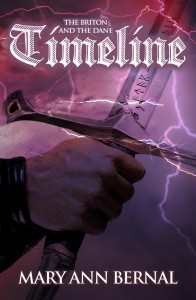 Dr. Gwyneth Franger is a renowned expert in early medieval England who is set upon learning the truth about the death of Lord Erik, the last descendant of the powerful House of Wareham. Her quest becomes an obsession, a condition that began with the discovery of a portrait of the tall and valiant warrior with which she forms an extraordinary and inexplicable bond.
Dr. Gwyneth Franger is a renowned expert in early medieval England who is set upon learning the truth about the death of Lord Erik, the last descendant of the powerful House of Wareham. Her quest becomes an obsession, a condition that began with the discovery of a portrait of the tall and valiant warrior with which she forms an extraordinary and inexplicable bond.
Digesting troves of mildewed scrolls and source documentation only enhances her belief that Lord Erik was brutally assassinated by a cabal of traitors in the pay of William the Bastard, shortly before the onslaught of the Norman Invasion.
On an archeological dig in Southern England, her team unearths an Anglo-Saxon fortress, a vast citadel built during the reign of Alfred the Great, which she believes was Lord Erik’s stronghold. In the midst of her excitement, she is awakened one night from her slumbers by a disconcerting anomaly emerging from the site.
Dr. Franger finds herself transported back to the Dark Ages and at the side of the noble Lord Erik who commands an army of elite Saxon warriors, a swift and mobile force able to deploy quickly throughout the kingdom to ward off invaders.
Witnessing the unrest firsthand, Gwyneth senses that her instincts had been right all along, and she is determined to learn the identities of the treacherous blackguards hiding in the shadows, villains who may well be posing as Lord Erik’s friends and counselors.
Will Gwyneth stop the assassins? Is she strong enough to walk away and watch her beloved Erik die? Or will she intervene, change the course of history and wipe out an entire timeline to save the man she loves with all her heart?
Purchase Links:
Amazon US
Amazon UK
Barnes and Noble
Tell Us One Thing interview.
**We sent Mary Ann 10 words beginning with I and asked her to tell us something about herself using each word…**
Indisputable
My striving for perfection is indisputable.
Incongruous
My fondness for animated characters, especially Spongebob Squarepants, might be considered incongruous amongst my peers.
Interesting
People find my enthusiasm for walking amidst archeological ruins interesting.
Impassioned
Everyone who knows me is aware of my impassioned support for my grandchildren’s sporting activities.
Impressive
My ability to turn lemons into lemonade is impressive.
Impetuous
Being a Capricorn, born on the cusp of Aquarius, contributes to my occasional impetuous behavior.
Intolerant
I am intolerant of bigots.
Imaginary
As a child, my sister and I used to play with a few imaginary friends.
Innocent
I have never pleaded innocent when presented with a speeding ticket.
Inspiring
People find my devotion to family inspiring.
**Thank you, Mary Ann **
**
ABOUT THE AUTHOR:
 Mary Ann Bernal, author of The Briton and the Dane novels, is an avid history buff whose area of interest focuses on Ninth Century Anglo-Saxon Britain during the Viking Age. While pursuing a degree in business administration, she managed to fit creative writing classes and workshops into her busy schedule to learn the craft, but it would take decades before her “Erik the Viking” novel was ultimately published.
Mary Ann Bernal, author of The Briton and the Dane novels, is an avid history buff whose area of interest focuses on Ninth Century Anglo-Saxon Britain during the Viking Age. While pursuing a degree in business administration, she managed to fit creative writing classes and workshops into her busy schedule to learn the craft, but it would take decades before her “Erik the Viking” novel was ultimately published.
Mary Ann is also a passionate supporter of the United States military, having been involved with letter writing campaigns and other support programs since Operation Desert Storm. She has appeared on The Morning Blend television show hosted by KMTV, the CBS television affiliate in Omaha, and was interviewed by the Omaha World-Herald for her volunteer work. She has also been a featured author on Triangle Variety Radio, The Phil Naessens Show, and The Writers Showcase, and has been interviewed extensively by American and European bloggers.
Mary Ann is a New York “expat,” and currently resides in Omaha, Nebraska.
Social Network Links:
Webpage: www.maryannbernal.com
Blog: http://maryannbernal.blogspot.com
Twitter: http://twitter.com/britonanddane
Pinterest: http://www.pinterest.com/maryannbernal
Facebook: https://www.facebook.com/TheBritonandtheDane
**Posted by Maria**
 This entry was posted in Interviews and tagged interview, mary ann bernal, Tell us one thing, the briton and the dane: timeline by Darcia and Maria. Bookmark the permalink.
This entry was posted in Interviews and tagged interview, mary ann bernal, Tell us one thing, the briton and the dane: timeline by Darcia and Maria. Bookmark the permalink.
Proudly powered by WordPress
#bit, #bit * {} #bit { bottom: -300px; font: 13px "Helvetica Neue",sans-serif; position: fixed; right: 10px; z-index: 999999; width: 230px; } .loggedout-follow-typekit { margin-right: 4.5em; } #bit a.bsub { background-color: #464646; background-image: -moz-linear-gradient(center bottom , #3F3F3F, #464646 5px); background: -webkit-gradient(linear, left top, left bottom, from(#3F3F3F), to(#464646)); filter: progid:DXImageTransform.Microsoft.gradient(startColorstr='#3F3F3F', endColorstr='#464646'); border: 0 none; box-shadow: 0 -1px 5px rgba(0, 0, 0, 0.2); color: #CCCCCC; display: block; float: right; font: 13px/28px "Helvetica Neue",sans-serif; letter-spacing: normal; outline-style: none; outline-width: 0; overflow: hidden; padding: 0 10px 0 8px; text-decoration: none !important; text-shadow: 0 -1px 0 #444444; } #bit a.bsub { border-radius: 2px 2px 0 0; } #bit a.bsub span { background-attachment: scroll; background-clip: border-box; background-color: transparent; background-image: url(http://quietfurybooks.com/bestsellerb... background-origin: padding-box; background-position: 2px 3px; background-repeat: no-repeat; background-size: 20% auto; padding-left: 18px; } #bit a:hover span, #bit a.bsub.open span { /*background-position: 0 -117px;*/ color: #FFFFFF !important; } #bit a.bsub.open { background: none repeat scroll 0 0 #333333; } #bitsubscribe { background: none repeat scroll 0 0 #464646; border-radius: 2px 0 0 0; color: #FFFFFF; margin-top: 27px; padding: 15px; width: 200px; float: right; margin-top: 0; } div#bitsubscribe.open { box-shadow: 0 0 8px rgba(0, 0, 0, 0.5); } #bitsubscribe div { overflow: hidden; } #bit h3, #bit #bitsubscribe h3 { color: #FFFFFF; font-family: "Helvetica Neue",Helvetica,Arial,sans-serif; font-size: 20px; font-weight: 300; margin: 0 0 0.5em !important; text-align: left; text-shadow: 0 1px 0 #333333; } #bit #bitsubscribe p { color: #FFFFFF; font: 300 15px/1.3em "Helvetica Neue",Helvetica,Arial,sans-serif; margin: 0 0 1em; text-shadow: 0 1px 0 #333333; } #bitsubscribe p a { margin: 20px 0 0; } #bit #bitsubscribe p.bit-follow-count { font-size: 13px; } #bitsubscribe input[type="submit"] { -moz-transition: all 0.25s ease-in-out 0s; -webkit-transition: all 0.25s ease-in-out 0s; -o-transition: all 0.25s ease-in-out 0s; -ms-transition: all 0.25s ease-in-out 0s; transition: all 0.25s ease-in-out 0s; background: -moz-linear-gradient(center top , #333333 0%, #111111 100%) repeat scroll 0 0 transparent; background: -webkit-gradient(linear, left top, left bottom, from(#333333), to(#111111)); filter: progid:DXImageTransform.Microsoft.gradient(startColorstr='#333333', endColorstr='#111111'); border: 1px solid #282828; border-radius: 11px 11px 11px 11px; box-shadow: 0 1px 0 #444444 inset; color: #CCCCCC; padding: 2px 20px; text-decoration: none; text-shadow: 0 1px 0 #000000; } #bitsubscribe input[type="submit"]:hover { background: -moz-linear-gradient(center top , #333333 0%, #222222 100%) repeat scroll 0 0 transparent; box-shadow: 0 1px 0 #4F4F4F inset; color: #FFFFFF; text-decoration: none; } #bitsubscribe input[type="submit"]:active { background: -moz-linear-gradient(center top , #111111 0%, #222222 100%) repeat scroll 0 0 transparent; box-shadow: 0 -1px 0 #333333 inset; color: #AAAAAA; text-decoration: none; } #bitsubscribe input[type="text"] { border-radius: 3px 3px 3px 3px; font: 300 15px "Helvetica Neue",Helvetica,Arial,sans-serif; } #bitsubscribe input[type="text"]:focus { border: 1px solid #000000; } #bitsubscribe.open { display: block; } #bsub-subscribe-button { margin: 0 auto; text-align: center; } #bitsubscribe #bsub-credit { border-top: 1px solid #3C3C3C; font: 11px "Helvetica Neue",sans-serif; margin: 0 0 -15px; padding: 7px 0; text-align: center; } #bitsubscribe #bsub-credit a { background: none repeat scroll 0 0 transparent; color: #AAAAAA; text-decoration: none; text-shadow: 0 1px 0 #262626; } #bitsubscribe #bsub-credit a:hover { background: none repeat scroll 0 0 transparent; color: #FFFFFF; }
Follow
Follow BestsellerBound RecommendsGet every new post delivered to your Inbox
Join other followers
 <div class="statcounter"><a title="web analytics" href="http://statcounter.com/">... class="statcounter" src="http://c.statcounter.com/8262020/0/98..." alt="web analytics" /></a></div> div#PIN_1397219507826_bg { position: fixed!important; top: 0px!important; left: 0px!important; right: 0px!important; bottom: 0px!important; height: 100%!important; width: 100%!important; background: #eee!important; z-index: 2147483641!important; } div#PIN_1397219507826_bd { z-index: 2147483642!important; text-align: center!important; position: absolute!important; width: 100%!important; top: 0!important; left: 0!important; right: 0!important; font: 16px helvetica neue,arial,san-serif!important; } div#PIN_1397219507826_bd #PIN_1397219507826_spacer { display: block!important; height: 60px!important; } div#PIN_1397219507826_bd div#PIN_1397219507826_hd { z-index: 2147483643!important; -moz-box-shadow: 0 1px 2px #aaa!important; -webkit-box-shadow: 0 1px 2px #aaa!important; box-shadow: 0 1px 2px #aaa!important; position: fixed!important; *position: absolute!important; width: 100%!important; top: 0!important; left: 0!important; right: 0!important; height: 45px!important; display: block!important; margin: 0!important; background: #fbf7f7!important; border-bottom: 1px solid #aaa!important; } div#PIN_1397219507826_bd div#PIN_1397219507826_hd.PIN_1397219507826_noHeader { height: 1px!important; background-color: #f2f2f2!important; -moz-box-shadow: none!important; -webkit-box-shadow: none!important; box-shadow: none!important; border: none!important; } div#PIN_1397219507826_bd div#PIN_1397219507826_hd a#PIN_1397219507826_x { display: inline-block!important; cursor: pointer!important; color: #524D4D!important; text-shadow: 0 1px #fff!important; float: right!important; line-height: 45px!important; font-size: 14px!important; font-weight: bold!important; text-align: center!important; width: 100px!important; border-left: 1px solid #aaa!important; } div#PIN_1397219507826_bd div#PIN_1397219507826_hd a#PIN_1397219507826_x:hover { color: #524D4D!important; background: #e1dfdf!important; text-decoration: none!important; } div#PIN_1397219507826_bd div#PIN_1397219507826_hd a#PIN_1397219507826_x:active { color: #fff!important; background: #cb2027!important; text-decoration: none!important; text-shadow: none!important; } div#PIN_1397219507826_bd div#PIN_1397219507826_hd #PIN_1397219507826_logo { height: 43px!important; width: 100px!important; display: inline-block!important; margin-right: -100px!important; background: transparent url(http://passets.pinterest.com/images/L...) 50% 50% no-repeat!important; border: none!important; } div#PIN_1397219507826_bd div#PIN_1397219507826_ct { margin: 0 auto 50px!important; position: relative!important; } div#PIN_1397219507826_bd div#PIN_1397219507826_ct span.PIN_1397219507826_thumb { background: #bbb!important; position: absolute!important; border-radius: 3px!important; -moz-box-shadow: 0 0 2px #555!important; -webkit-box-shadow: 0 0 2px #555!important; box-shadow: 0 0 2px #555!important; overflow: hidden!important; } div#PIN_1397219507826_bd div#PIN_1397219507826_ct span.PIN_1397219507826_thumb span.PIN_1397219507826_pin { position: absolute!important; top: 0!important; left: 0!important; width: 100%!important; cursor: pointer!important; zoom: 1!important; background-position: 50% 50%!important; background-repeat: no-repeat!important; -moz-transition-property: background-color!important; -moz-transition-duration: .25s!important; -webkit-transition-property: background-color!important; -webkit-transition-duration: .25s!important; transition-property: background-color!important; transition-duration: .25s!important; } div#PIN_1397219507826_bd div#PIN_1397219507826_ct span.PIN_1397219507826_thumb span.PIN_1397219507826_pin img.PIN_1397219507826_thumb { border: none!important; margin: 0!important; padding: 0!important; } div#PIN_1397219507826_bd div#PIN_1397219507826_ct span.PIN_1397219507826_thumb:hover span.PIN_1397219507826_pin { background-image: url(http://passets.pinterest.com/images/b... background-color: rgba(0, 0, 0, .25)!important; } div#PIN_1397219507826_bd div#PIN_1397219507826_ct span.PIN_1397219507826_thumb:hover div.PIN_1397219507826_info { background-color: #fff!important; background-image: url(http://passets.pinterest.com/images/b... } div#PIN_1397219507826_bd div#PIN_1397219507826_ct span.PIN_1397219507826_thumb span.PIN_1397219507826_play { position: absolute!important; top: 0!important; left: 0!important; width: 100%!important; background: transparent url(http://passets.pinterest.com/images/b...) 50% 50% no-repeat!important; } div#PIN_1397219507826_bd div#PIN_1397219507826_ct span.PIN_1397219507826_thumb small { position: absolute!important; right: 0!important; left: 0!important; width: 100%!important; height: 30px!important; line-height: 30px!important; text-align: center!important; font-size: 10px!important; background: #fff!important; color: #000!important; border-top: 1px solid #eee!important; } div#PIN_1397219507826_bd div#PIN_1397219507826_ct span.PIN_1397219507826_thumb div.PIN_1397219507826_info { position: absolute!important; border-top: 1px solid #eee!important; left: 0!important; right: 0!important; bottom: 0!important; width: 100%!important; color: #333!important; padding: 14px 0 14px 0!important; line-height: 17px!important; font-size: 13px!important; font-style: normal!important; font-weight: normal!important; text-align: left!important; text-shadow: none!important; overflow: hidden!important; background-color: #f6f6f6!important; background-position: 215px 15px!important; background-repeat: no-repeat!important; } div#PIN_1397219507826_bd div#PIN_1397219507826_ct span.PIN_1397219507826_thumb div.PIN_1397219507826_info.PIN_1397219507826_hazAttrib { padding-bottom: 45px!important; } div#PIN_1397219507826_bd div#PIN_1397219507826_ct span.PIN_1397219507826_thumb div.PIN_1397219507826_info span { display: block!important; margin: 0 18px 0 14px!important; } div#PIN_1397219507826_bd div#PIN_1397219507826_ct span.PIN_1397219507826_thumb div.PIN_1397219507826_info span.PIN_1397219507826_attrib { border-top: 1px solid #eee!important; position: absolute!important; bottom: 0!important; margin: 0!important; left: 0!important; right: 0!important; height: 30px!important; line-height: 30px!important; font-size: 11px!important; text-indent: 14px!important; background: #fff!important; } div#PIN_1397219507826_bd div#PIN_1397219507826_ct span.PIN_1397219507826_thumb div.PIN_1397219507826_info span.PIN_1397219507826_attrib img.PIN_1397219507826_attrib { vertical-align: middle!important; margin: 0!important; padding: 0!important; } @media only screen and (-webkit-min-device-pixel-ratio: 2) #PIN_1397219507826_logo { background-size: 100px 26px!important; background-image: url(http://passets.pinterest.com/images/L... }
<div class="statcounter"><a title="web analytics" href="http://statcounter.com/">... class="statcounter" src="http://c.statcounter.com/8262020/0/98..." alt="web analytics" /></a></div> div#PIN_1397219507826_bg { position: fixed!important; top: 0px!important; left: 0px!important; right: 0px!important; bottom: 0px!important; height: 100%!important; width: 100%!important; background: #eee!important; z-index: 2147483641!important; } div#PIN_1397219507826_bd { z-index: 2147483642!important; text-align: center!important; position: absolute!important; width: 100%!important; top: 0!important; left: 0!important; right: 0!important; font: 16px helvetica neue,arial,san-serif!important; } div#PIN_1397219507826_bd #PIN_1397219507826_spacer { display: block!important; height: 60px!important; } div#PIN_1397219507826_bd div#PIN_1397219507826_hd { z-index: 2147483643!important; -moz-box-shadow: 0 1px 2px #aaa!important; -webkit-box-shadow: 0 1px 2px #aaa!important; box-shadow: 0 1px 2px #aaa!important; position: fixed!important; *position: absolute!important; width: 100%!important; top: 0!important; left: 0!important; right: 0!important; height: 45px!important; display: block!important; margin: 0!important; background: #fbf7f7!important; border-bottom: 1px solid #aaa!important; } div#PIN_1397219507826_bd div#PIN_1397219507826_hd.PIN_1397219507826_noHeader { height: 1px!important; background-color: #f2f2f2!important; -moz-box-shadow: none!important; -webkit-box-shadow: none!important; box-shadow: none!important; border: none!important; } div#PIN_1397219507826_bd div#PIN_1397219507826_hd a#PIN_1397219507826_x { display: inline-block!important; cursor: pointer!important; color: #524D4D!important; text-shadow: 0 1px #fff!important; float: right!important; line-height: 45px!important; font-size: 14px!important; font-weight: bold!important; text-align: center!important; width: 100px!important; border-left: 1px solid #aaa!important; } div#PIN_1397219507826_bd div#PIN_1397219507826_hd a#PIN_1397219507826_x:hover { color: #524D4D!important; background: #e1dfdf!important; text-decoration: none!important; } div#PIN_1397219507826_bd div#PIN_1397219507826_hd a#PIN_1397219507826_x:active { color: #fff!important; background: #cb2027!important; text-decoration: none!important; text-shadow: none!important; } div#PIN_1397219507826_bd div#PIN_1397219507826_hd #PIN_1397219507826_logo { height: 43px!important; width: 100px!important; display: inline-block!important; margin-right: -100px!important; background: transparent url(http://passets.pinterest.com/images/L...) 50% 50% no-repeat!important; border: none!important; } div#PIN_1397219507826_bd div#PIN_1397219507826_ct { margin: 0 auto 50px!important; position: relative!important; } div#PIN_1397219507826_bd div#PIN_1397219507826_ct span.PIN_1397219507826_thumb { background: #bbb!important; position: absolute!important; border-radius: 3px!important; -moz-box-shadow: 0 0 2px #555!important; -webkit-box-shadow: 0 0 2px #555!important; box-shadow: 0 0 2px #555!important; overflow: hidden!important; } div#PIN_1397219507826_bd div#PIN_1397219507826_ct span.PIN_1397219507826_thumb span.PIN_1397219507826_pin { position: absolute!important; top: 0!important; left: 0!important; width: 100%!important; cursor: pointer!important; zoom: 1!important; background-position: 50% 50%!important; background-repeat: no-repeat!important; -moz-transition-property: background-color!important; -moz-transition-duration: .25s!important; -webkit-transition-property: background-color!important; -webkit-transition-duration: .25s!important; transition-property: background-color!important; transition-duration: .25s!important; } div#PIN_1397219507826_bd div#PIN_1397219507826_ct span.PIN_1397219507826_thumb span.PIN_1397219507826_pin img.PIN_1397219507826_thumb { border: none!important; margin: 0!important; padding: 0!important; } div#PIN_1397219507826_bd div#PIN_1397219507826_ct span.PIN_1397219507826_thumb:hover span.PIN_1397219507826_pin { background-image: url(http://passets.pinterest.com/images/b... background-color: rgba(0, 0, 0, .25)!important; } div#PIN_1397219507826_bd div#PIN_1397219507826_ct span.PIN_1397219507826_thumb:hover div.PIN_1397219507826_info { background-color: #fff!important; background-image: url(http://passets.pinterest.com/images/b... } div#PIN_1397219507826_bd div#PIN_1397219507826_ct span.PIN_1397219507826_thumb span.PIN_1397219507826_play { position: absolute!important; top: 0!important; left: 0!important; width: 100%!important; background: transparent url(http://passets.pinterest.com/images/b...) 50% 50% no-repeat!important; } div#PIN_1397219507826_bd div#PIN_1397219507826_ct span.PIN_1397219507826_thumb small { position: absolute!important; right: 0!important; left: 0!important; width: 100%!important; height: 30px!important; line-height: 30px!important; text-align: center!important; font-size: 10px!important; background: #fff!important; color: #000!important; border-top: 1px solid #eee!important; } div#PIN_1397219507826_bd div#PIN_1397219507826_ct span.PIN_1397219507826_thumb div.PIN_1397219507826_info { position: absolute!important; border-top: 1px solid #eee!important; left: 0!important; right: 0!important; bottom: 0!important; width: 100%!important; color: #333!important; padding: 14px 0 14px 0!important; line-height: 17px!important; font-size: 13px!important; font-style: normal!important; font-weight: normal!important; text-align: left!important; text-shadow: none!important; overflow: hidden!important; background-color: #f6f6f6!important; background-position: 215px 15px!important; background-repeat: no-repeat!important; } div#PIN_1397219507826_bd div#PIN_1397219507826_ct span.PIN_1397219507826_thumb div.PIN_1397219507826_info.PIN_1397219507826_hazAttrib { padding-bottom: 45px!important; } div#PIN_1397219507826_bd div#PIN_1397219507826_ct span.PIN_1397219507826_thumb div.PIN_1397219507826_info span { display: block!important; margin: 0 18px 0 14px!important; } div#PIN_1397219507826_bd div#PIN_1397219507826_ct span.PIN_1397219507826_thumb div.PIN_1397219507826_info span.PIN_1397219507826_attrib { border-top: 1px solid #eee!important; position: absolute!important; bottom: 0!important; margin: 0!important; left: 0!important; right: 0!important; height: 30px!important; line-height: 30px!important; font-size: 11px!important; text-indent: 14px!important; background: #fff!important; } div#PIN_1397219507826_bd div#PIN_1397219507826_ct span.PIN_1397219507826_thumb div.PIN_1397219507826_info span.PIN_1397219507826_attrib img.PIN_1397219507826_attrib { vertical-align: middle!important; margin: 0!important; padding: 0!important; } @media only screen and (-webkit-min-device-pixel-ratio: 2) #PIN_1397219507826_logo { background-size: 100px 26px!important; background-image: url(http://passets.pinterest.com/images/L... }

BestsellerBound RecommendsIndie's Best Books and Authors

“Tell Us One Thing” Interview with Mary Ann BernalPosted on April 11, 2014 by Darcia and Maria **Today we have a ‘Tell Us One Thing interview with author Mary Ann Bernal. But first, let’s find out a bit about her book, The Briton and the Dane: Timeline**
 Dr. Gwyneth Franger is a renowned expert in early medieval England who is set upon learning the truth about the death of Lord Erik, the last descendant of the powerful House of Wareham. Her quest becomes an obsession, a condition that began with the discovery of a portrait of the tall and valiant warrior with which she forms an extraordinary and inexplicable bond.
Dr. Gwyneth Franger is a renowned expert in early medieval England who is set upon learning the truth about the death of Lord Erik, the last descendant of the powerful House of Wareham. Her quest becomes an obsession, a condition that began with the discovery of a portrait of the tall and valiant warrior with which she forms an extraordinary and inexplicable bond.Digesting troves of mildewed scrolls and source documentation only enhances her belief that Lord Erik was brutally assassinated by a cabal of traitors in the pay of William the Bastard, shortly before the onslaught of the Norman Invasion.
On an archeological dig in Southern England, her team unearths an Anglo-Saxon fortress, a vast citadel built during the reign of Alfred the Great, which she believes was Lord Erik’s stronghold. In the midst of her excitement, she is awakened one night from her slumbers by a disconcerting anomaly emerging from the site.
Dr. Franger finds herself transported back to the Dark Ages and at the side of the noble Lord Erik who commands an army of elite Saxon warriors, a swift and mobile force able to deploy quickly throughout the kingdom to ward off invaders.
Witnessing the unrest firsthand, Gwyneth senses that her instincts had been right all along, and she is determined to learn the identities of the treacherous blackguards hiding in the shadows, villains who may well be posing as Lord Erik’s friends and counselors.
Will Gwyneth stop the assassins? Is she strong enough to walk away and watch her beloved Erik die? Or will she intervene, change the course of history and wipe out an entire timeline to save the man she loves with all her heart?
Purchase Links:
Amazon US
Amazon UK
Barnes and Noble
Tell Us One Thing interview.
**We sent Mary Ann 10 words beginning with I and asked her to tell us something about herself using each word…**
Indisputable
My striving for perfection is indisputable.
Incongruous
My fondness for animated characters, especially Spongebob Squarepants, might be considered incongruous amongst my peers.
Interesting
People find my enthusiasm for walking amidst archeological ruins interesting.
Impassioned
Everyone who knows me is aware of my impassioned support for my grandchildren’s sporting activities.
Impressive
My ability to turn lemons into lemonade is impressive.
Impetuous
Being a Capricorn, born on the cusp of Aquarius, contributes to my occasional impetuous behavior.
Intolerant
I am intolerant of bigots.
Imaginary
As a child, my sister and I used to play with a few imaginary friends.
Innocent
I have never pleaded innocent when presented with a speeding ticket.
Inspiring
People find my devotion to family inspiring.
**Thank you, Mary Ann
 **
**ABOUT THE AUTHOR:
 Mary Ann Bernal, author of The Briton and the Dane novels, is an avid history buff whose area of interest focuses on Ninth Century Anglo-Saxon Britain during the Viking Age. While pursuing a degree in business administration, she managed to fit creative writing classes and workshops into her busy schedule to learn the craft, but it would take decades before her “Erik the Viking” novel was ultimately published.
Mary Ann Bernal, author of The Briton and the Dane novels, is an avid history buff whose area of interest focuses on Ninth Century Anglo-Saxon Britain during the Viking Age. While pursuing a degree in business administration, she managed to fit creative writing classes and workshops into her busy schedule to learn the craft, but it would take decades before her “Erik the Viking” novel was ultimately published.Mary Ann is also a passionate supporter of the United States military, having been involved with letter writing campaigns and other support programs since Operation Desert Storm. She has appeared on The Morning Blend television show hosted by KMTV, the CBS television affiliate in Omaha, and was interviewed by the Omaha World-Herald for her volunteer work. She has also been a featured author on Triangle Variety Radio, The Phil Naessens Show, and The Writers Showcase, and has been interviewed extensively by American and European bloggers.
Mary Ann is a New York “expat,” and currently resides in Omaha, Nebraska.
Social Network Links:
Webpage: www.maryannbernal.com
Blog: http://maryannbernal.blogspot.com
Twitter: http://twitter.com/britonanddane
Pinterest: http://www.pinterest.com/maryannbernal
Facebook: https://www.facebook.com/TheBritonandtheDane
**Posted by Maria**
 This entry was posted in Interviews and tagged interview, mary ann bernal, Tell us one thing, the briton and the dane: timeline by Darcia and Maria. Bookmark the permalink.
This entry was posted in Interviews and tagged interview, mary ann bernal, Tell us one thing, the briton and the dane: timeline by Darcia and Maria. Bookmark the permalink. Proudly powered by WordPress
#bit, #bit * {} #bit { bottom: -300px; font: 13px "Helvetica Neue",sans-serif; position: fixed; right: 10px; z-index: 999999; width: 230px; } .loggedout-follow-typekit { margin-right: 4.5em; } #bit a.bsub { background-color: #464646; background-image: -moz-linear-gradient(center bottom , #3F3F3F, #464646 5px); background: -webkit-gradient(linear, left top, left bottom, from(#3F3F3F), to(#464646)); filter: progid:DXImageTransform.Microsoft.gradient(startColorstr='#3F3F3F', endColorstr='#464646'); border: 0 none; box-shadow: 0 -1px 5px rgba(0, 0, 0, 0.2); color: #CCCCCC; display: block; float: right; font: 13px/28px "Helvetica Neue",sans-serif; letter-spacing: normal; outline-style: none; outline-width: 0; overflow: hidden; padding: 0 10px 0 8px; text-decoration: none !important; text-shadow: 0 -1px 0 #444444; } #bit a.bsub { border-radius: 2px 2px 0 0; } #bit a.bsub span { background-attachment: scroll; background-clip: border-box; background-color: transparent; background-image: url(http://quietfurybooks.com/bestsellerb... background-origin: padding-box; background-position: 2px 3px; background-repeat: no-repeat; background-size: 20% auto; padding-left: 18px; } #bit a:hover span, #bit a.bsub.open span { /*background-position: 0 -117px;*/ color: #FFFFFF !important; } #bit a.bsub.open { background: none repeat scroll 0 0 #333333; } #bitsubscribe { background: none repeat scroll 0 0 #464646; border-radius: 2px 0 0 0; color: #FFFFFF; margin-top: 27px; padding: 15px; width: 200px; float: right; margin-top: 0; } div#bitsubscribe.open { box-shadow: 0 0 8px rgba(0, 0, 0, 0.5); } #bitsubscribe div { overflow: hidden; } #bit h3, #bit #bitsubscribe h3 { color: #FFFFFF; font-family: "Helvetica Neue",Helvetica,Arial,sans-serif; font-size: 20px; font-weight: 300; margin: 0 0 0.5em !important; text-align: left; text-shadow: 0 1px 0 #333333; } #bit #bitsubscribe p { color: #FFFFFF; font: 300 15px/1.3em "Helvetica Neue",Helvetica,Arial,sans-serif; margin: 0 0 1em; text-shadow: 0 1px 0 #333333; } #bitsubscribe p a { margin: 20px 0 0; } #bit #bitsubscribe p.bit-follow-count { font-size: 13px; } #bitsubscribe input[type="submit"] { -moz-transition: all 0.25s ease-in-out 0s; -webkit-transition: all 0.25s ease-in-out 0s; -o-transition: all 0.25s ease-in-out 0s; -ms-transition: all 0.25s ease-in-out 0s; transition: all 0.25s ease-in-out 0s; background: -moz-linear-gradient(center top , #333333 0%, #111111 100%) repeat scroll 0 0 transparent; background: -webkit-gradient(linear, left top, left bottom, from(#333333), to(#111111)); filter: progid:DXImageTransform.Microsoft.gradient(startColorstr='#333333', endColorstr='#111111'); border: 1px solid #282828; border-radius: 11px 11px 11px 11px; box-shadow: 0 1px 0 #444444 inset; color: #CCCCCC; padding: 2px 20px; text-decoration: none; text-shadow: 0 1px 0 #000000; } #bitsubscribe input[type="submit"]:hover { background: -moz-linear-gradient(center top , #333333 0%, #222222 100%) repeat scroll 0 0 transparent; box-shadow: 0 1px 0 #4F4F4F inset; color: #FFFFFF; text-decoration: none; } #bitsubscribe input[type="submit"]:active { background: -moz-linear-gradient(center top , #111111 0%, #222222 100%) repeat scroll 0 0 transparent; box-shadow: 0 -1px 0 #333333 inset; color: #AAAAAA; text-decoration: none; } #bitsubscribe input[type="text"] { border-radius: 3px 3px 3px 3px; font: 300 15px "Helvetica Neue",Helvetica,Arial,sans-serif; } #bitsubscribe input[type="text"]:focus { border: 1px solid #000000; } #bitsubscribe.open { display: block; } #bsub-subscribe-button { margin: 0 auto; text-align: center; } #bitsubscribe #bsub-credit { border-top: 1px solid #3C3C3C; font: 11px "Helvetica Neue",sans-serif; margin: 0 0 -15px; padding: 7px 0; text-align: center; } #bitsubscribe #bsub-credit a { background: none repeat scroll 0 0 transparent; color: #AAAAAA; text-decoration: none; text-shadow: 0 1px 0 #262626; } #bitsubscribe #bsub-credit a:hover { background: none repeat scroll 0 0 transparent; color: #FFFFFF; }
Follow
Follow BestsellerBound RecommendsGet every new post delivered to your Inbox
Join other followers
 <div class="statcounter"><a title="web analytics" href="http://statcounter.com/">... class="statcounter" src="http://c.statcounter.com/8262020/0/98..." alt="web analytics" /></a></div> div#PIN_1397219507826_bg { position: fixed!important; top: 0px!important; left: 0px!important; right: 0px!important; bottom: 0px!important; height: 100%!important; width: 100%!important; background: #eee!important; z-index: 2147483641!important; } div#PIN_1397219507826_bd { z-index: 2147483642!important; text-align: center!important; position: absolute!important; width: 100%!important; top: 0!important; left: 0!important; right: 0!important; font: 16px helvetica neue,arial,san-serif!important; } div#PIN_1397219507826_bd #PIN_1397219507826_spacer { display: block!important; height: 60px!important; } div#PIN_1397219507826_bd div#PIN_1397219507826_hd { z-index: 2147483643!important; -moz-box-shadow: 0 1px 2px #aaa!important; -webkit-box-shadow: 0 1px 2px #aaa!important; box-shadow: 0 1px 2px #aaa!important; position: fixed!important; *position: absolute!important; width: 100%!important; top: 0!important; left: 0!important; right: 0!important; height: 45px!important; display: block!important; margin: 0!important; background: #fbf7f7!important; border-bottom: 1px solid #aaa!important; } div#PIN_1397219507826_bd div#PIN_1397219507826_hd.PIN_1397219507826_noHeader { height: 1px!important; background-color: #f2f2f2!important; -moz-box-shadow: none!important; -webkit-box-shadow: none!important; box-shadow: none!important; border: none!important; } div#PIN_1397219507826_bd div#PIN_1397219507826_hd a#PIN_1397219507826_x { display: inline-block!important; cursor: pointer!important; color: #524D4D!important; text-shadow: 0 1px #fff!important; float: right!important; line-height: 45px!important; font-size: 14px!important; font-weight: bold!important; text-align: center!important; width: 100px!important; border-left: 1px solid #aaa!important; } div#PIN_1397219507826_bd div#PIN_1397219507826_hd a#PIN_1397219507826_x:hover { color: #524D4D!important; background: #e1dfdf!important; text-decoration: none!important; } div#PIN_1397219507826_bd div#PIN_1397219507826_hd a#PIN_1397219507826_x:active { color: #fff!important; background: #cb2027!important; text-decoration: none!important; text-shadow: none!important; } div#PIN_1397219507826_bd div#PIN_1397219507826_hd #PIN_1397219507826_logo { height: 43px!important; width: 100px!important; display: inline-block!important; margin-right: -100px!important; background: transparent url(http://passets.pinterest.com/images/L...) 50% 50% no-repeat!important; border: none!important; } div#PIN_1397219507826_bd div#PIN_1397219507826_ct { margin: 0 auto 50px!important; position: relative!important; } div#PIN_1397219507826_bd div#PIN_1397219507826_ct span.PIN_1397219507826_thumb { background: #bbb!important; position: absolute!important; border-radius: 3px!important; -moz-box-shadow: 0 0 2px #555!important; -webkit-box-shadow: 0 0 2px #555!important; box-shadow: 0 0 2px #555!important; overflow: hidden!important; } div#PIN_1397219507826_bd div#PIN_1397219507826_ct span.PIN_1397219507826_thumb span.PIN_1397219507826_pin { position: absolute!important; top: 0!important; left: 0!important; width: 100%!important; cursor: pointer!important; zoom: 1!important; background-position: 50% 50%!important; background-repeat: no-repeat!important; -moz-transition-property: background-color!important; -moz-transition-duration: .25s!important; -webkit-transition-property: background-color!important; -webkit-transition-duration: .25s!important; transition-property: background-color!important; transition-duration: .25s!important; } div#PIN_1397219507826_bd div#PIN_1397219507826_ct span.PIN_1397219507826_thumb span.PIN_1397219507826_pin img.PIN_1397219507826_thumb { border: none!important; margin: 0!important; padding: 0!important; } div#PIN_1397219507826_bd div#PIN_1397219507826_ct span.PIN_1397219507826_thumb:hover span.PIN_1397219507826_pin { background-image: url(http://passets.pinterest.com/images/b... background-color: rgba(0, 0, 0, .25)!important; } div#PIN_1397219507826_bd div#PIN_1397219507826_ct span.PIN_1397219507826_thumb:hover div.PIN_1397219507826_info { background-color: #fff!important; background-image: url(http://passets.pinterest.com/images/b... } div#PIN_1397219507826_bd div#PIN_1397219507826_ct span.PIN_1397219507826_thumb span.PIN_1397219507826_play { position: absolute!important; top: 0!important; left: 0!important; width: 100%!important; background: transparent url(http://passets.pinterest.com/images/b...) 50% 50% no-repeat!important; } div#PIN_1397219507826_bd div#PIN_1397219507826_ct span.PIN_1397219507826_thumb small { position: absolute!important; right: 0!important; left: 0!important; width: 100%!important; height: 30px!important; line-height: 30px!important; text-align: center!important; font-size: 10px!important; background: #fff!important; color: #000!important; border-top: 1px solid #eee!important; } div#PIN_1397219507826_bd div#PIN_1397219507826_ct span.PIN_1397219507826_thumb div.PIN_1397219507826_info { position: absolute!important; border-top: 1px solid #eee!important; left: 0!important; right: 0!important; bottom: 0!important; width: 100%!important; color: #333!important; padding: 14px 0 14px 0!important; line-height: 17px!important; font-size: 13px!important; font-style: normal!important; font-weight: normal!important; text-align: left!important; text-shadow: none!important; overflow: hidden!important; background-color: #f6f6f6!important; background-position: 215px 15px!important; background-repeat: no-repeat!important; } div#PIN_1397219507826_bd div#PIN_1397219507826_ct span.PIN_1397219507826_thumb div.PIN_1397219507826_info.PIN_1397219507826_hazAttrib { padding-bottom: 45px!important; } div#PIN_1397219507826_bd div#PIN_1397219507826_ct span.PIN_1397219507826_thumb div.PIN_1397219507826_info span { display: block!important; margin: 0 18px 0 14px!important; } div#PIN_1397219507826_bd div#PIN_1397219507826_ct span.PIN_1397219507826_thumb div.PIN_1397219507826_info span.PIN_1397219507826_attrib { border-top: 1px solid #eee!important; position: absolute!important; bottom: 0!important; margin: 0!important; left: 0!important; right: 0!important; height: 30px!important; line-height: 30px!important; font-size: 11px!important; text-indent: 14px!important; background: #fff!important; } div#PIN_1397219507826_bd div#PIN_1397219507826_ct span.PIN_1397219507826_thumb div.PIN_1397219507826_info span.PIN_1397219507826_attrib img.PIN_1397219507826_attrib { vertical-align: middle!important; margin: 0!important; padding: 0!important; } @media only screen and (-webkit-min-device-pixel-ratio: 2) #PIN_1397219507826_logo { background-size: 100px 26px!important; background-image: url(http://passets.pinterest.com/images/L... }
<div class="statcounter"><a title="web analytics" href="http://statcounter.com/">... class="statcounter" src="http://c.statcounter.com/8262020/0/98..." alt="web analytics" /></a></div> div#PIN_1397219507826_bg { position: fixed!important; top: 0px!important; left: 0px!important; right: 0px!important; bottom: 0px!important; height: 100%!important; width: 100%!important; background: #eee!important; z-index: 2147483641!important; } div#PIN_1397219507826_bd { z-index: 2147483642!important; text-align: center!important; position: absolute!important; width: 100%!important; top: 0!important; left: 0!important; right: 0!important; font: 16px helvetica neue,arial,san-serif!important; } div#PIN_1397219507826_bd #PIN_1397219507826_spacer { display: block!important; height: 60px!important; } div#PIN_1397219507826_bd div#PIN_1397219507826_hd { z-index: 2147483643!important; -moz-box-shadow: 0 1px 2px #aaa!important; -webkit-box-shadow: 0 1px 2px #aaa!important; box-shadow: 0 1px 2px #aaa!important; position: fixed!important; *position: absolute!important; width: 100%!important; top: 0!important; left: 0!important; right: 0!important; height: 45px!important; display: block!important; margin: 0!important; background: #fbf7f7!important; border-bottom: 1px solid #aaa!important; } div#PIN_1397219507826_bd div#PIN_1397219507826_hd.PIN_1397219507826_noHeader { height: 1px!important; background-color: #f2f2f2!important; -moz-box-shadow: none!important; -webkit-box-shadow: none!important; box-shadow: none!important; border: none!important; } div#PIN_1397219507826_bd div#PIN_1397219507826_hd a#PIN_1397219507826_x { display: inline-block!important; cursor: pointer!important; color: #524D4D!important; text-shadow: 0 1px #fff!important; float: right!important; line-height: 45px!important; font-size: 14px!important; font-weight: bold!important; text-align: center!important; width: 100px!important; border-left: 1px solid #aaa!important; } div#PIN_1397219507826_bd div#PIN_1397219507826_hd a#PIN_1397219507826_x:hover { color: #524D4D!important; background: #e1dfdf!important; text-decoration: none!important; } div#PIN_1397219507826_bd div#PIN_1397219507826_hd a#PIN_1397219507826_x:active { color: #fff!important; background: #cb2027!important; text-decoration: none!important; text-shadow: none!important; } div#PIN_1397219507826_bd div#PIN_1397219507826_hd #PIN_1397219507826_logo { height: 43px!important; width: 100px!important; display: inline-block!important; margin-right: -100px!important; background: transparent url(http://passets.pinterest.com/images/L...) 50% 50% no-repeat!important; border: none!important; } div#PIN_1397219507826_bd div#PIN_1397219507826_ct { margin: 0 auto 50px!important; position: relative!important; } div#PIN_1397219507826_bd div#PIN_1397219507826_ct span.PIN_1397219507826_thumb { background: #bbb!important; position: absolute!important; border-radius: 3px!important; -moz-box-shadow: 0 0 2px #555!important; -webkit-box-shadow: 0 0 2px #555!important; box-shadow: 0 0 2px #555!important; overflow: hidden!important; } div#PIN_1397219507826_bd div#PIN_1397219507826_ct span.PIN_1397219507826_thumb span.PIN_1397219507826_pin { position: absolute!important; top: 0!important; left: 0!important; width: 100%!important; cursor: pointer!important; zoom: 1!important; background-position: 50% 50%!important; background-repeat: no-repeat!important; -moz-transition-property: background-color!important; -moz-transition-duration: .25s!important; -webkit-transition-property: background-color!important; -webkit-transition-duration: .25s!important; transition-property: background-color!important; transition-duration: .25s!important; } div#PIN_1397219507826_bd div#PIN_1397219507826_ct span.PIN_1397219507826_thumb span.PIN_1397219507826_pin img.PIN_1397219507826_thumb { border: none!important; margin: 0!important; padding: 0!important; } div#PIN_1397219507826_bd div#PIN_1397219507826_ct span.PIN_1397219507826_thumb:hover span.PIN_1397219507826_pin { background-image: url(http://passets.pinterest.com/images/b... background-color: rgba(0, 0, 0, .25)!important; } div#PIN_1397219507826_bd div#PIN_1397219507826_ct span.PIN_1397219507826_thumb:hover div.PIN_1397219507826_info { background-color: #fff!important; background-image: url(http://passets.pinterest.com/images/b... } div#PIN_1397219507826_bd div#PIN_1397219507826_ct span.PIN_1397219507826_thumb span.PIN_1397219507826_play { position: absolute!important; top: 0!important; left: 0!important; width: 100%!important; background: transparent url(http://passets.pinterest.com/images/b...) 50% 50% no-repeat!important; } div#PIN_1397219507826_bd div#PIN_1397219507826_ct span.PIN_1397219507826_thumb small { position: absolute!important; right: 0!important; left: 0!important; width: 100%!important; height: 30px!important; line-height: 30px!important; text-align: center!important; font-size: 10px!important; background: #fff!important; color: #000!important; border-top: 1px solid #eee!important; } div#PIN_1397219507826_bd div#PIN_1397219507826_ct span.PIN_1397219507826_thumb div.PIN_1397219507826_info { position: absolute!important; border-top: 1px solid #eee!important; left: 0!important; right: 0!important; bottom: 0!important; width: 100%!important; color: #333!important; padding: 14px 0 14px 0!important; line-height: 17px!important; font-size: 13px!important; font-style: normal!important; font-weight: normal!important; text-align: left!important; text-shadow: none!important; overflow: hidden!important; background-color: #f6f6f6!important; background-position: 215px 15px!important; background-repeat: no-repeat!important; } div#PIN_1397219507826_bd div#PIN_1397219507826_ct span.PIN_1397219507826_thumb div.PIN_1397219507826_info.PIN_1397219507826_hazAttrib { padding-bottom: 45px!important; } div#PIN_1397219507826_bd div#PIN_1397219507826_ct span.PIN_1397219507826_thumb div.PIN_1397219507826_info span { display: block!important; margin: 0 18px 0 14px!important; } div#PIN_1397219507826_bd div#PIN_1397219507826_ct span.PIN_1397219507826_thumb div.PIN_1397219507826_info span.PIN_1397219507826_attrib { border-top: 1px solid #eee!important; position: absolute!important; bottom: 0!important; margin: 0!important; left: 0!important; right: 0!important; height: 30px!important; line-height: 30px!important; font-size: 11px!important; text-indent: 14px!important; background: #fff!important; } div#PIN_1397219507826_bd div#PIN_1397219507826_ct span.PIN_1397219507826_thumb div.PIN_1397219507826_info span.PIN_1397219507826_attrib img.PIN_1397219507826_attrib { vertical-align: middle!important; margin: 0!important; padding: 0!important; } @media only screen and (-webkit-min-device-pixel-ratio: 2) #PIN_1397219507826_logo { background-size: 100px 26px!important; background-image: url(http://passets.pinterest.com/images/L... }

Published on April 11, 2014 05:41
History Trivia - Llywelyn ap Iorweth, Prince of Gwynedd, dies
April 11
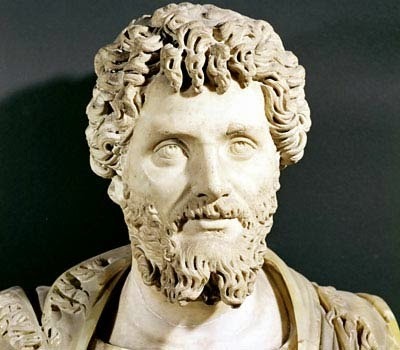
146 Lucius Septimius Severus, Emperor of Rome 193-211, was born.
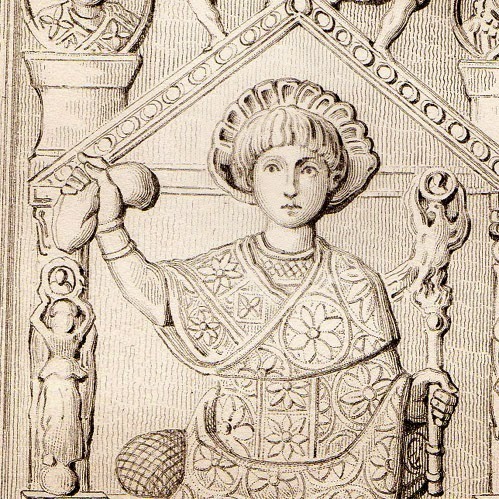
491 Flavius Anastasius became Byzantine Emperor, with the name of Anastasius I.
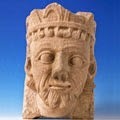
1240 Llywelyn ap Iorweth, Prince of Gwynedd, died. Llywelyn the Great managed to unite most of Wales under his control, but most of his reign was marked by conflict with King John of England, whose illegitimate daughter Joan was Llywelyn's wife.
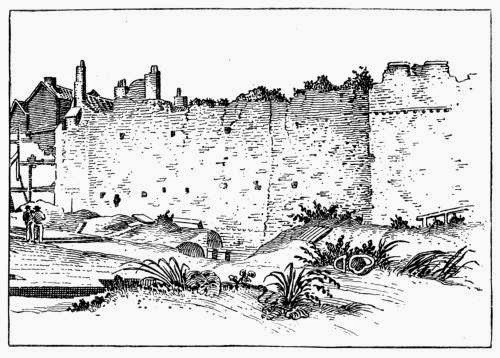
1471 King Edward IV of England conquered London from Henry VI.

1689 William III and Mary II were crowned as joint sovereigns of Britain.


146 Lucius Septimius Severus, Emperor of Rome 193-211, was born.

491 Flavius Anastasius became Byzantine Emperor, with the name of Anastasius I.

1240 Llywelyn ap Iorweth, Prince of Gwynedd, died. Llywelyn the Great managed to unite most of Wales under his control, but most of his reign was marked by conflict with King John of England, whose illegitimate daughter Joan was Llywelyn's wife.

1471 King Edward IV of England conquered London from Henry VI.

1689 William III and Mary II were crowned as joint sovereigns of Britain.

Published on April 11, 2014 05:39
April 10, 2014
History Trivia - Louis III becomes King of the Western Franks.
April 10

847 St Leo IV began his reign as Catholic Pope.

879 Louis III became King of the Western Franks.

1500 Ludovico Sforza was captured by the Swiss troops at Novara and was handed over to the French.

1512 James V of Scotland was born. His only legitimate child to survive to adulthood was Mary, Queen of Scots. His illegitimate son, the Earl of Moray, became regent of Scotland when Mary abdicated.


847 St Leo IV began his reign as Catholic Pope.

879 Louis III became King of the Western Franks.

1500 Ludovico Sforza was captured by the Swiss troops at Novara and was handed over to the French.

1512 James V of Scotland was born. His only legitimate child to survive to adulthood was Mary, Queen of Scots. His illegitimate son, the Earl of Moray, became regent of Scotland when Mary abdicated.

Published on April 10, 2014 05:15
April 9, 2014
Inside the mummies' embalmed bodies – courtesy of a hospital CT scanner
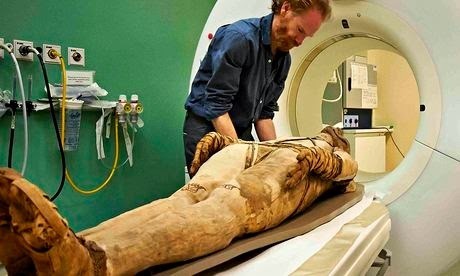
The British Museum's next big exhibition reveals secrets that experts have been able only to guess at – until now
Mark Brown, arts correspondent
theguardian.com,
A mummy undergoes a CT scan at the Royal Brompton Hospital. Scientists scanned eight mummies, turning the data into 3D images. Photograph: British Museum/PASpare a thought for the unknown adult mummified in a Theban necropolis more than 2,500 years go. Not only did he suffer the most excruciating, possibly life-threatening dental abscesses, but the embalmer botched the afterlife preparation, leaving bits of brain in his skull as well as a broken section of the spatula he was using to remove it.
Then there's Tamut, a temple singer with enough calcified plaque in her arteries to risk a heart attack or stroke.
Tamut and the unknown adult male are two of the British Museum's 120 Egyptian and Sudanese mummies. Experts now know far more about them because of new "electronic excavations" using the latest generation of medical CT scanners.
The museum on Wednesday revealed the fresh insights as it announced details of an interactive exhibition, Ancient lives, new discoveries, which will be £10 for adults and free for those particularly fascinated by brains being scooped out of skulls through the nose – the under 16s.
John Taylor, the museum's mummy curator, said the new techniques had allowed researchers to discover much more about life and death along the Nile more than 5,000 years ago.
The museum has not unwrapped a body in 200 years. "We don't want to disturb what is inside these bodies," said Taylor. "They are incredibly fragile, and they are also human beings who actually lived."
The museum has been x-raying mummies since the 1960s but, as the technology has improved, the results have dramatically improved.
The latest finds have been uncovered thanks to the newest CT scanners which are used in hospitals, allowing researchers to discover more about age, lifestyle, health and what the people actually looked like. "It allows us to take a journey beneath the wrappings, beneath the skin to see what is inside," said Taylor.
There will be eight mummies in the show. Details of two were revealed yesterday. The unknown Thebes man, mummified around 600BC, is particularly interesting because of the bits of tool that were left in the poor man's skull.
Daniel Antoine, who is responsible for the museum's human remains collection, said embalmers had "great skill and knowledge of human anatomy", managing to extract a brain through a hole no bigger than 2cm by 2cm.
In this case, something went wrong. The embalmer would probably have used a metal rod to break the bones at the top of the nose to then extract the brain with a wooden or perhaps reedy spatula – it is this that somehow broke and remains in the man's skull along with brain.
Antoine said they also found five dental abscesses which "would have caused significant discomfort and may have been a cause of death" because if the infection had got in to his bloodstream it could have caused septicaemia.
Tamut lived in Thebes around 900BC and had a top job as a temple singer, or chantress, of the god Amun. Because of her high status she was given the best possible mummification. Researchers have scanned and made 3D copies of amulets that adorned her body.
They have also detected a pair of small metal plates which cover the incision that the embalmer would have made in her left abdomen to drain out her internal organs. They have on them carvings of a protective eye, presumably to help heal the wound magically.
Tamut went in to the latest dual-energy CT scanner at the Royal Brompton hospital, which allowed researchers to make images of her blood vessels, so visitors will be able to see calcified plaque in her femur artery, for which people would take statins today.
Antoine said: "In her case it is a large deposit and, if a fragment had detached and moved away into the heart, she would have had a heart attack and if in the brain, she would have had a stroke. It is remarkable to be able to see plaque in such clarity."
The eight mummies in the show cover a period of 4,000 years, from 3,500BC to AD700. Taylor hopes even more secrets will be revealed in years to come, including being able to read hieroglyphic inscriptions on objects inside the mummies.
"It is not by any means the end of the road because the technology is moving on rapidly all the time, and we're hoping in the next few years we'll be able to continue scanning more mummies and revealing more remarkable facts."
• Ancient lives, new discoveries is at the British Museum 22 May-30 November, sponsored by Julius Baer

Published on April 09, 2014 16:44
Israeli archaeologists uncover 3,300-year-old coffin, gold signet
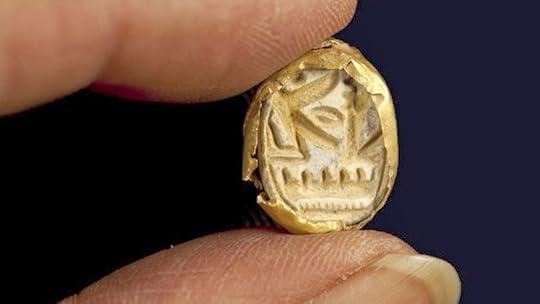
Archaeologists uncovered a Bronze Age ceramic coffin and a golden scarab in Israel's Jezreel Valley, the Israel Antiquities Authority (IAA) announced Wednesday.
A ring with an Egyptian scarab seal was found with the name of the crown worn by Egyptian pharaoh Seti I, who ruled Egypt in the Late Bronze Age. Seti I was the father of Ramses II and some scholars identify him as the pharaoh in the biblical story of the Israelite's exodus from Egypt. The seal of Seti I helped the archaeologists date the site back to the thirteenth century B.C.
A clay coffin with an adult skeleton was also found at the site."We discovered a unique and rare find: a cylindrical clay coffin with an anthropoidal lid (a cover fashioned in the image of a person) surrounded by a variety of pottery consisting mainly of storage vessels for food, tableware, cultic vessels and animal bones," IAA excavation directors, Dr. Edwin van den Brink, Dan Kirzner and Dr. Ron Be’eri said in a press release.
It was custom to use these items as offerings for the gods and the artifacts were also used to provide the dead with sustenance in the afterlife, they explained.
Pottery, a bronze dagger and bowl and hammered pieces of bronze were found buried next to the coffin.
"Since the vessels interred with the individual were produced locally, we assume the deceased was an official of Canaanite origin who was engaged in the service of the Egyptian government," the researchers said. "Another possibility is that the coffin belonged to a wealthy individual who imitated Egyptian funerary customs."
Only several anthropoidal coffins have previously been uncovered in Israel, they added. The most recent were found 50 years ago in the Gaza's Deir el-Balah.
"An ordinary person could not afford the purchase of such a coffin," the researchers continued. "It is obvious the deceased was a member of the local elite."
The grave sites of two men and two women were also found near the coffin. The discovery confirms Egyptian control of the Jezreel Valley in the thirteenth century B.C.
The discoveries were made during a routine salvage excavation conducted by the IAA prior to the construction of a main pipeline that will convey natural gas to Ramat Gavriel in Migdal Ha-Emek in the North of Israel.
http://www.foxnews.com/science/2014/04/09/israeli-archaeologists-uncover-3300-year-old-coffin-gold-signet/#

Published on April 09, 2014 16:15
History Trivia - Christopher of Bavaria appointed King of Denmark.
April 9
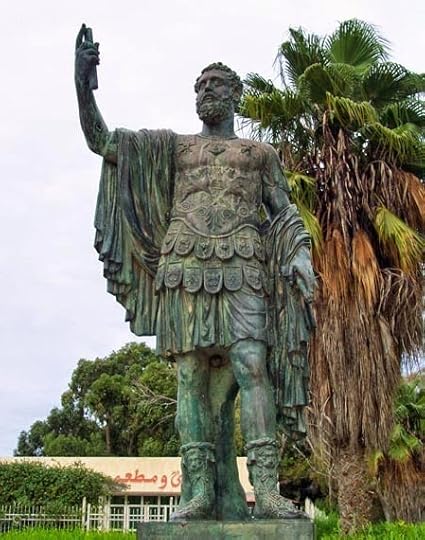
193 Septimius Severus was proclaimed Roman Emperor by the army in Illyricum (Balkans).
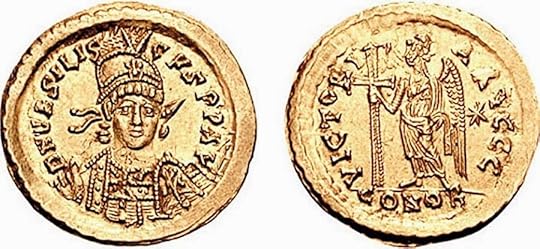
475 Byzantine Emperor Basiliscus issued a circular letter (Enkyklikon) to the bishops of his empire, supporting the Monophysite Christological position.
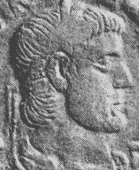 491 Eastern Roman Emperor Zeno died at an approximate age of 65.
491 Eastern Roman Emperor Zeno died at an approximate age of 65.

999 Gerbert of Aurillac became Pope Sylvester II.
 1413 Henry V was crowned King of England.
1413 Henry V was crowned King of England.
 1440 Christopher of Bavaria was appointed King of Denmark.
1440 Christopher of Bavaria was appointed King of Denmark.

1483 King Edward IV of England died.

1492 Lorenzo de' Medici died.


193 Septimius Severus was proclaimed Roman Emperor by the army in Illyricum (Balkans).

475 Byzantine Emperor Basiliscus issued a circular letter (Enkyklikon) to the bishops of his empire, supporting the Monophysite Christological position.
 491 Eastern Roman Emperor Zeno died at an approximate age of 65.
491 Eastern Roman Emperor Zeno died at an approximate age of 65. 
999 Gerbert of Aurillac became Pope Sylvester II.
 1413 Henry V was crowned King of England.
1413 Henry V was crowned King of England.  1440 Christopher of Bavaria was appointed King of Denmark.
1440 Christopher of Bavaria was appointed King of Denmark. 
1483 King Edward IV of England died.

1492 Lorenzo de' Medici died.

Published on April 09, 2014 06:37
April 8, 2014
Mr. Chuckles stirs the Wizard's Cauldron, checking out Heavy Metal author Sarah Tipper

The Wizard speaks:
This week, humourist and insane metal fan Sarah Tipper joins us once more to celebrate the release of her fourth book, The Very Metal Diary of Cleo Howard.
Sarah attracted a cult following for her Eviscerated Panda trilogy, which has featured around the Cauldron before, but with this latest book, methinks, with some luck, she could attract a wider audience
Want to read more? Click on the link.
http://greenwizard62.blogspot.com/2014/04/heavy-metal-author-sarah-tipper-talks.html

Published on April 08, 2014 14:50
Drone Images Reveal Buried Ancient Village in New Mexico
By Megan Gannon
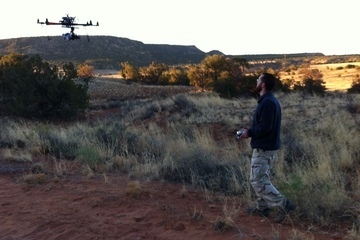
 Archaeologists flew a drone over an ancient site called Blue J in northwestern New Mexico to obtain aerial thermal images of the site.
Archaeologists flew a drone over an ancient site called Blue J in northwestern New Mexico to obtain aerial thermal images of the site.
Credit: Katie Simon View full size image
Thermal images captured by an small drone allowed archaeologists to peer under the surface of the New Mexican desert floor, revealing never-before-seen structures in an ancient Native American settlement.
Called Blue J, this 1,000-year-old village was first identified by archaeologists in the 1970s. It sits about 43 miles (70 kilometers) south of the famed Chaco Canyon site in northwestern New Mexico and contains nearly 60 ancestral Puebloan houses around what was once a large spring.
Now, the ruins of Blue J are obscured by vegetation and buried in eroded sandstone blown in from nearby cliffs. The ancient structures have been only partially studied through excavations. Last June, a team of archaeologists flew a small camera-equipped drone over the site to find out what infrared images might reveal under the surface. [Chaco Canyon Photos: The Center of an Ancient World]
"I was really pleased with the results," said Jesse Casana, an archaeologist from the University of Arkansas. "This work illustrates the very important role that UAVs (unmanned aerial vehicles) have for scientific research."
Casana said his co-author, John Kantner of the University of North Florida, had previously excavated at the site and the drone images showed stone compounds Kantner had already identified and ones that he didn't know about.
For example, the thermal images revealed a dark circle just inside the wall of a plaza area, which could represent wetter, cooler soil filling a kiva, or a huge, underground structure circular that would have been used for public gatherings and ceremonies. Finding a kiva at Blue J would be significant; the site has been considered unusual among its neighbors because it lacks the monumental great houses and subterranean kivas that are the hallmark of Chaco-era Pueblo sites, the authors wrote in the May issue of the Journal of Archaeological Science.
The images also could guide archaeologists' trowels before they ever break ground.
"Now that we know what household compounds look like in thermal imaging, we could use it to prospect for structures at other sites," Casana told Live Science.
How it works
Archaeological features like bricks and stone walls retain and emit warmth differently than the surrounding soil, meaning heat maps can provide an outline of rubble buried underground. Casana said archaeologists have been talking about using thermal imaging technology to probe ancient sites for decades, but it's been almost impossible to operationalize.
"To do it, you need to get a really high-resolution thermal image collected at the right time of day," Casana said. "It involves tasking a plane with a very expensive sensor to fly at a very low altitude, and that’s just not something that archaeologists could afford."
Casana primarily studies archaeology of the Middle East and was leading a dig in Syria until civil war broke out in the country in 2011. In 2012, he got a Start-Up grant from the National Endowment of the Humanities to study aerial thermographic imaging. Casana has been investigating archaeological sites with an eight-rotor CineStar 8 remote-controlled copter, which he built from a $6,000 kit a few years ago. So far, he has tested the technology at a site in Cyprus, a Plains Village settlement in South Dakota and the ancient city of Cahokia near modern-day St. Louis, among others. He said he would be taking the craft to Iraq this summer for a new project in Kurdistan.
The uncertain future of drones for science
Archaeologists and other scientists who want to study the Earth from above are increasingly looking at drones as a research tool as the cost for unmanned aerial vehicles, or UAVs, goes down. But the technology is hardly perfect, and there are legal hurdles, too.
"People who fly them for fun say it's not a question of if you'll crash it, but when and how badly," Casana said. He found that to be true in his trials. Hardware sometimes comes loose mid-flight and the software on the ground occasionally freezes, Casana said. He travels with replacement parts and backup systems like balloons and kites.
Meanwhile, the lack of regulations for UAVs in the United States makes it difficult to implement the technology just yet.
The Federal Aviation Administration has set a goal to implement commercial drone regulations by 2015 and recently designated six drone-testing centers across the country to research how UAVs could be safely introduced to U.S. skies. FAA officials have held that it is illegal to fly commercial drones until they write those rules, though they suffered a setback last month when a judge for the National Transportation Safety Board overturned the FAA's decision to fine a man $10,000 for using a drone to shoot a promotional video, Bloomberg News reported.
To get around these legal gray areas, Casana said he had to rely student volunteers to operate the drone in New Mexico this summer. ("Hobbyists" have no problem flying the aircraft.) He expressed concern that debates about drone use often ignore scientific applications.
"When legislators think about use of technology, they often don't think about science," Casana said. "They need to come up with some regulations. Until they do, it's really kind of hamstringing science."
http://www.livescience.com/44679-drone-images-reveal-buried-archaeological-ruins.html


 Archaeologists flew a drone over an ancient site called Blue J in northwestern New Mexico to obtain aerial thermal images of the site.
Archaeologists flew a drone over an ancient site called Blue J in northwestern New Mexico to obtain aerial thermal images of the site.Credit: Katie Simon View full size image
Thermal images captured by an small drone allowed archaeologists to peer under the surface of the New Mexican desert floor, revealing never-before-seen structures in an ancient Native American settlement.
Called Blue J, this 1,000-year-old village was first identified by archaeologists in the 1970s. It sits about 43 miles (70 kilometers) south of the famed Chaco Canyon site in northwestern New Mexico and contains nearly 60 ancestral Puebloan houses around what was once a large spring.
Now, the ruins of Blue J are obscured by vegetation and buried in eroded sandstone blown in from nearby cliffs. The ancient structures have been only partially studied through excavations. Last June, a team of archaeologists flew a small camera-equipped drone over the site to find out what infrared images might reveal under the surface. [Chaco Canyon Photos: The Center of an Ancient World]
"I was really pleased with the results," said Jesse Casana, an archaeologist from the University of Arkansas. "This work illustrates the very important role that UAVs (unmanned aerial vehicles) have for scientific research."
Casana said his co-author, John Kantner of the University of North Florida, had previously excavated at the site and the drone images showed stone compounds Kantner had already identified and ones that he didn't know about.
For example, the thermal images revealed a dark circle just inside the wall of a plaza area, which could represent wetter, cooler soil filling a kiva, or a huge, underground structure circular that would have been used for public gatherings and ceremonies. Finding a kiva at Blue J would be significant; the site has been considered unusual among its neighbors because it lacks the monumental great houses and subterranean kivas that are the hallmark of Chaco-era Pueblo sites, the authors wrote in the May issue of the Journal of Archaeological Science.
The images also could guide archaeologists' trowels before they ever break ground.
"Now that we know what household compounds look like in thermal imaging, we could use it to prospect for structures at other sites," Casana told Live Science.
How it works
Archaeological features like bricks and stone walls retain and emit warmth differently than the surrounding soil, meaning heat maps can provide an outline of rubble buried underground. Casana said archaeologists have been talking about using thermal imaging technology to probe ancient sites for decades, but it's been almost impossible to operationalize.
"To do it, you need to get a really high-resolution thermal image collected at the right time of day," Casana said. "It involves tasking a plane with a very expensive sensor to fly at a very low altitude, and that’s just not something that archaeologists could afford."
Casana primarily studies archaeology of the Middle East and was leading a dig in Syria until civil war broke out in the country in 2011. In 2012, he got a Start-Up grant from the National Endowment of the Humanities to study aerial thermographic imaging. Casana has been investigating archaeological sites with an eight-rotor CineStar 8 remote-controlled copter, which he built from a $6,000 kit a few years ago. So far, he has tested the technology at a site in Cyprus, a Plains Village settlement in South Dakota and the ancient city of Cahokia near modern-day St. Louis, among others. He said he would be taking the craft to Iraq this summer for a new project in Kurdistan.
The uncertain future of drones for science
Archaeologists and other scientists who want to study the Earth from above are increasingly looking at drones as a research tool as the cost for unmanned aerial vehicles, or UAVs, goes down. But the technology is hardly perfect, and there are legal hurdles, too.
"People who fly them for fun say it's not a question of if you'll crash it, but when and how badly," Casana said. He found that to be true in his trials. Hardware sometimes comes loose mid-flight and the software on the ground occasionally freezes, Casana said. He travels with replacement parts and backup systems like balloons and kites.
Meanwhile, the lack of regulations for UAVs in the United States makes it difficult to implement the technology just yet.
The Federal Aviation Administration has set a goal to implement commercial drone regulations by 2015 and recently designated six drone-testing centers across the country to research how UAVs could be safely introduced to U.S. skies. FAA officials have held that it is illegal to fly commercial drones until they write those rules, though they suffered a setback last month when a judge for the National Transportation Safety Board overturned the FAA's decision to fine a man $10,000 for using a drone to shoot a promotional video, Bloomberg News reported.
To get around these legal gray areas, Casana said he had to rely student volunteers to operate the drone in New Mexico this summer. ("Hobbyists" have no problem flying the aircraft.) He expressed concern that debates about drone use often ignore scientific applications.
"When legislators think about use of technology, they often don't think about science," Casana said. "They need to come up with some regulations. Until they do, it's really kind of hamstringing science."
http://www.livescience.com/44679-drone-images-reveal-buried-archaeological-ruins.html

Published on April 08, 2014 11:44



